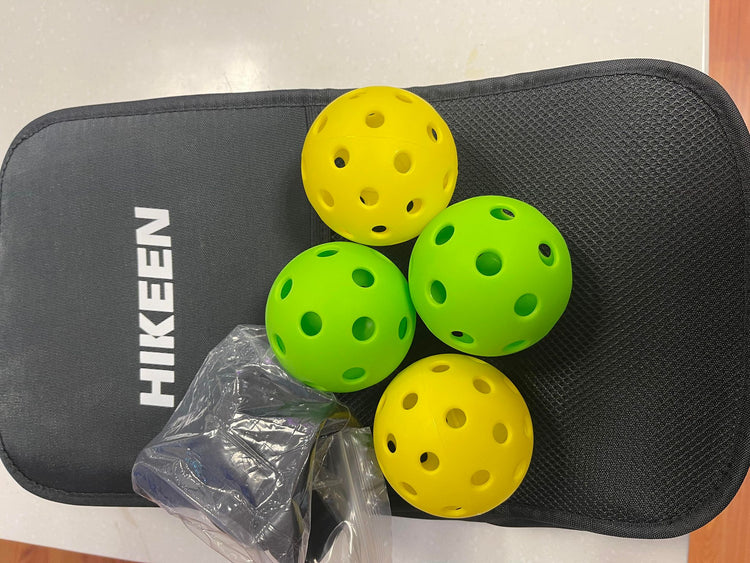Pickleball made of durable materials for smooth play. Pickleballs are made primarily from a combination of polymer, plastic materials, and resin. Explore different types of pickleball balls for your game. Discover a pickleball ball’s composition and explore its fascinating materials. Get insights into the construction and characteristics of this essential equipment for the game.
What Are Pickleballs Made Of:
Pickleball has become more popular in recent years. Are you eager to step into the pickleball world? The rapidly growing sport is recognized for its unique paddle and fast-paced gameplay. But have you ever wondered, “What are pickleballs made of?” Today, we will explore one pivotal aspect of this exciting game – the pickleball ball! Join us as we unravel the mystery behind its composition and discover why it is crucial to your success on the court. Get ready to be captivated by the exciting secrets hidden within each bounce of a pickleball, whether you’re a newbie or a seasoned player.
Specifications Of A Pickleball Ball
The International Pickleball Federation (IFP) maintains a list of approved pickleballs. This list includes pickleballs tested and certified to meet the IFP’s specifications. The specifications of a standard pickleball ball, according to official rules, are as follows:
| Specification | Range |
| Diameter | 2.874 inches (7.30cm) to 2.972 inches (7.55cm) |
| Circumference | 9.03 inches (22.93cm) to 9.34 inches (23.72cm) |
| Weight | 0.78 ounces (22.1 grams) to 0.935 ounces (26.5 grams) |
| Bounce | 30 inches (76.2cm) to 34 inches (86.4cm) when dropped from a height of 78 inches (198.1cm) onto a granite surface plate. |
| Holes | Must have between 26 and 40 holes. |
| Color | Must be Single color. |
When choosing a pickleball, it is essential to consider the type of court surface you will be playing on and your playing style. Indoor pickleballs are typically made of softer materials than outdoor pickleballs, as the indoor court surfaces are not as hard.
What Is Material Pickleballs Made Of
Pickleballs are made primarily from a combination of polymer, plastic materials, and resin.
Hard plastic: Hard plastic is the most frequently used to make pickleballs Because it is long-lasting and has a reliable bounce.
Resin: Resin pickleballs are typically softer and more flexible than hard plastic pickleballs. This makes them easier to control but may not last as long as hard plastic pickleballs. Some popular resins used for pickleballs include polyurethane (PU) and thermoplastic elastomer (TPE).
Polymer: Polymer pickleballs are a relatively new type made from various synthetic materials. Polymer pickleballs are typically designed to be durable and lightweight, with a consistent bounce. Polypropylene (PP), polyethylene (PE), and polycarbonate (PC) are typical examples of rigid polymers typically employed in the manufacturing of pickleball balls.
Key Points About Pickleball Materials
Pickleballs are crafted using various materials to meet specific standards and performance criteria. Here are some key points about the materials used to make pickleball:
1. Durable and Smooth Surfaces: The USA Pickleball Association (USAPA) mandates that pickleballs be constructed from durable materials with smooth surfaces. These materials can include resins, rubber, plastic, or combinations thereof.
2. Restrictions on Texture and Hole Shape: Manufacturers are prohibited from adding texture to the ball’s surface. The number and shape of holes are also subject to restrictions to ensure consistent gameplay.
3. Specific Technical Requirements: The ball must be made of smooth molded material with a uniform color. It should have between twenty-six and forty circular, evenly spaced holes. When dropped from a height of seventy-eight inches, the ball must bounce between thirty and thirty-four inches high.
4. Hardness and Material Variance: The hardness of the plastic used is crucial, as the ball must maintain its round shape and bounce consistently. According to official rules, the allowable variance in roundness typically does not exceed around 0.02 inches.
The ball’s hardness should fall within a range of forty to fifty on the Durometer Shore D Scale, which measures the hardness of plastics and rubbers. While plastic is commonly used, other materials like hard rubber may also be employed if they meet weight, bounce, diameter, and other technical specifications.
Manufacturing Process Of Pickleball
Creating pickleball balls involves a precise manufacturing process to guarantee quality and consistency. Here’s an overview of how these balls are made:
Material Selection
High-quality polymer is chosen for the outer shell, and cork or polypropylene is selected for the core.
Molding
The polymer material is molded into two halves that will later be fused.
Core Placement
The cork or polypropylene core is placed inside one of the molded halves.
Fusing
The two halves are fused, creating a seamless outer shell with a securely enclosed core.
Hole Drilling
Holes are drilled into the ball following a specific pattern, ensuring consistent performance.
Quality Control
Each pickleball ball undergoes rigorous quality control checks to meet the required weight, bounce, and roundness standards.

